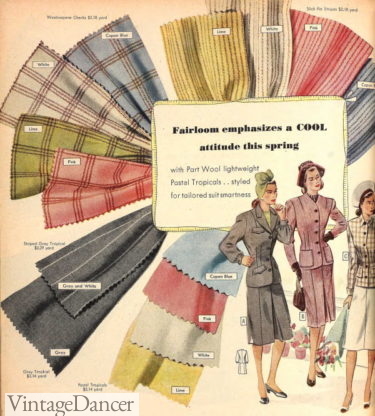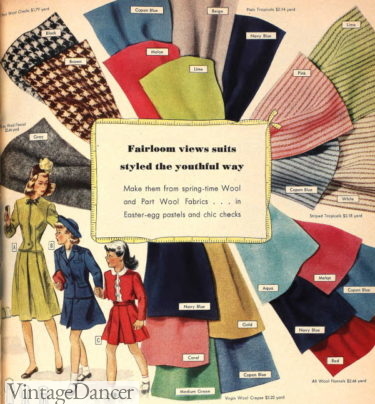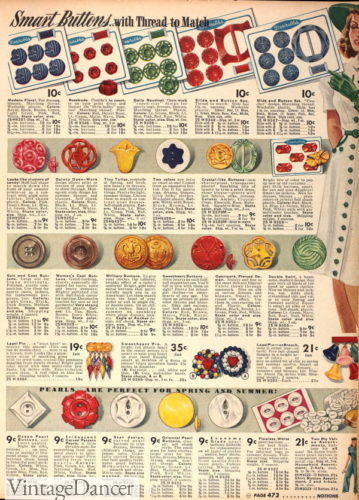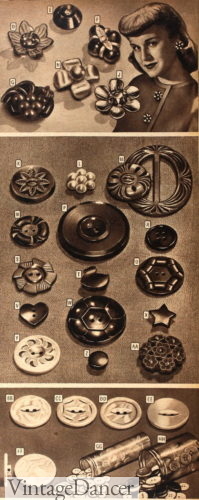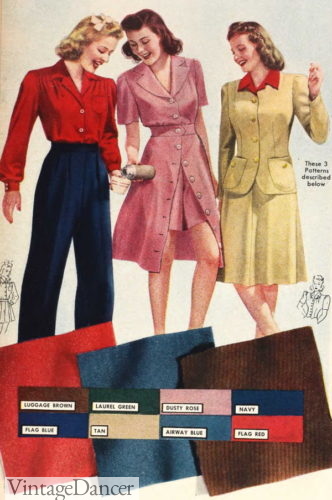
1942 casual fashion fabric for sport, play and leisure
The 1940s was unique in that it brought a diverse selection of women’s fabrics and patterns to the mainstream. Because of this, it can be difficult to distinguish what is a 1940s print compared to a print from another decade, simply because there were so many designs, styles and colors.
In the early ’40s when WWII restricted fabric production, most clothing came in a limited palette. Most suits, sports clothing, work clothing, and separates were solid colors. 1940s prints were mostly for casual dresses, playsuits, blouses, and children’s clothing.
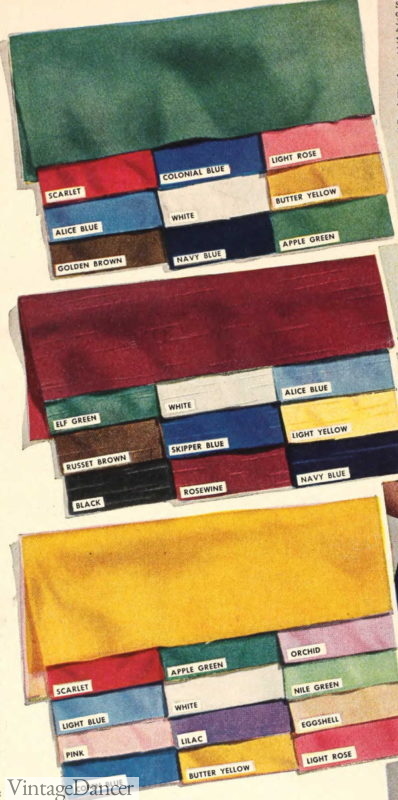
1941 colors, cotton fabrics
When sewing your own 1940s clothing, it’s important to pick fabric and trim in the color palette of the era. This guide will help you get a sense of the popular 1940s colors, fabrics and prints in women’s fashion during the 1940s.
Men’s fabrics are discussed in the article on 1940s men’s suits.
1940s Colors in Fashion
While colors came in and out of fashion for most of the decade, there was a certain set that were considered “classics.” These were mostly primary colors- strong, bold, and vibrant.
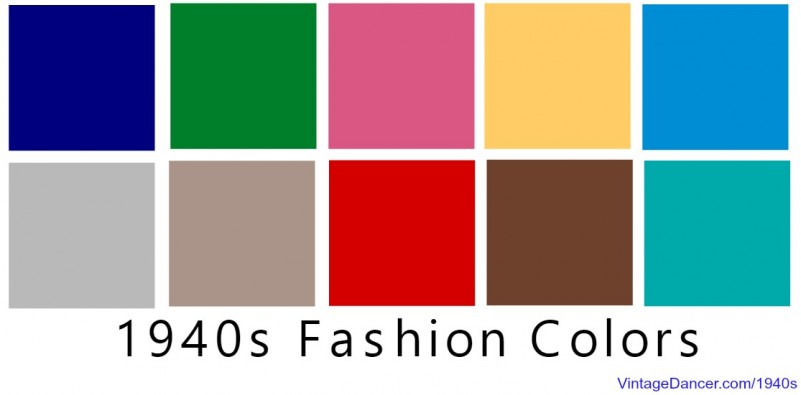
1940s classic clothing colors
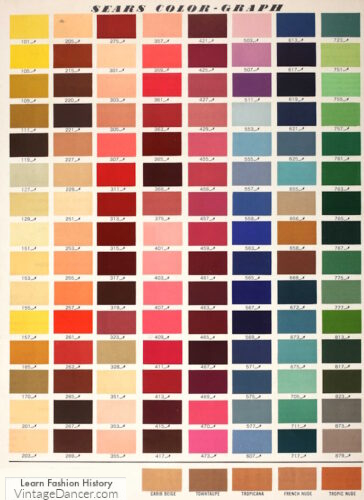
1941 Sears Color-Graph
Year-round colors were navy blue, brown, beige, black, red, green (Kelley green, mint green, aqua green), grey, rose pink, copen blue (a medium blue), violet, black, white and golden yellow.
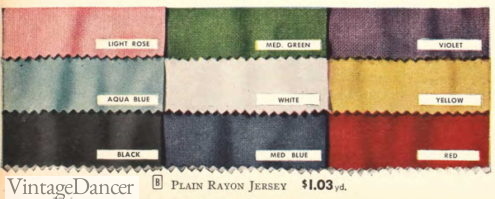
1945 rayon jersey basic colors
In the summer, lighter versions of these colors were common: pastel pink, pastel yellow, pastel blue, etc.

1941 spring colors
1940s color names (American) included:
- GREEN: mint green, aqua, almond green, lime green, nile green, apple green, forrest
- BLUE: copen blue, heather blue, teal blue, cadet blue, colonial, alice
- BROWN: luggage brown, beige, cocoa brown, russet, chicory
- YELLOW: gold, topaz, butter, maize, peach
- Red/ Pink: rose wine, fuchsia, red, sapphire, pink, coral, sunset rose, dusty rose, scarlet, claret, rio
- Purple: violet, orchid, lilac
Of these fashion colors, the most popular 1940s colors are navy blue, wine red, yellow gold, forest green, bright red and copen blue (a medium blue). When making a 1940s outfit you can’t go wrong with one of these classic 40s colors.
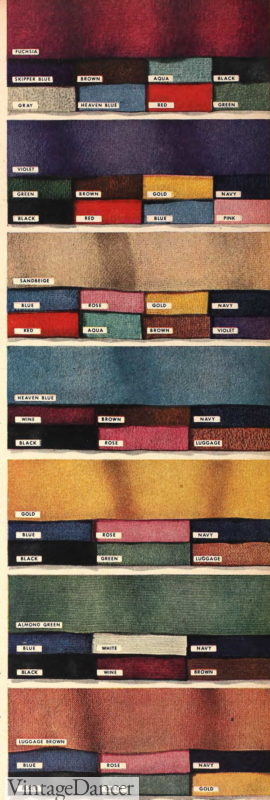
1946 wool crepe colors
1940s Fabrics
I am not skilled at describing the difference between one fabric and another, so here is my best attempt as some of the staple 1940s fabrics:
Rayon: Rayon changed the clothing industry forever. This fabric could be made to look and feel like almost any expensive fabric on the market, which quickly increased its popularity among home sewers. Rayon crepe was the most popular fabric for dresses followed by rayon wool for suiting.
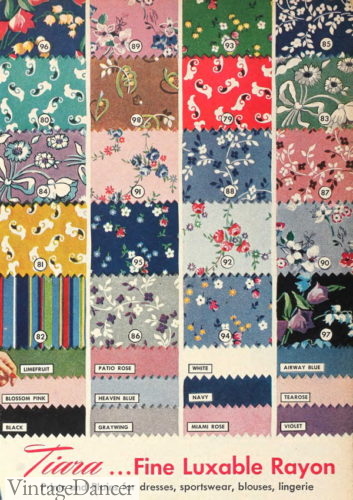
1942 rayon fabrics: for dresses, sportswear, blouses and lingerie
Wool: Wool and wool blends blends made up suits, skirts and outerwear, and they became the staple fabric for winter. Summer or tropical weight wool was also used in suiting and light jackets. Most wool fabrics were plain colors but some prints such as narrow stripes, plaid and checks added variety.
- 1947 tropical weight wool fabric
- 1947 wool suiting fabrics
Cotton: A soft or stiff cotton could be light and airy (voile, swiss, lawn), covered in embroidered holes (eyelet), broadcloth (sturdy and basic), twill (thick with a subtle texture) and seersucker (a waffle weave common in summer stripes). Cotton is easy to sew with, easy to wear, and with care lasts a long time. But it’s important to know cotton is prone to fading with frequent laundering.
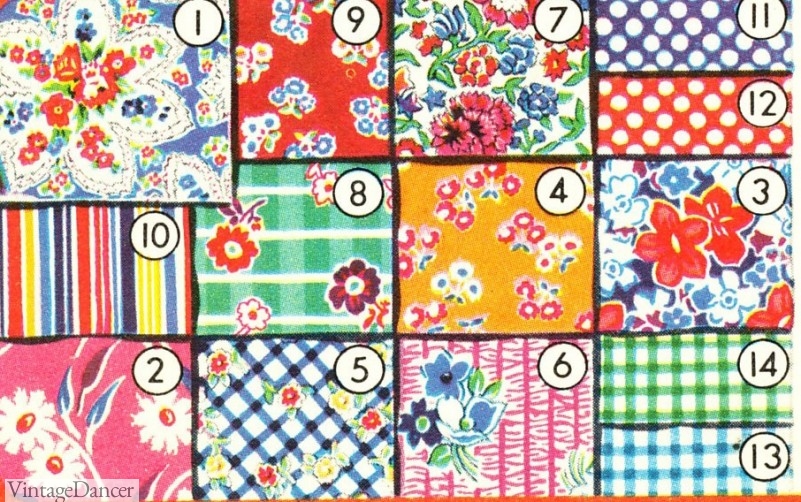
1940 Fun prints in cotton

1943 sheer cotton prints in voile, lawn, and swiss
Jersey: A very soft knit cotton or Rayon material usually worn in the fall or winter since it’s also rather warm.
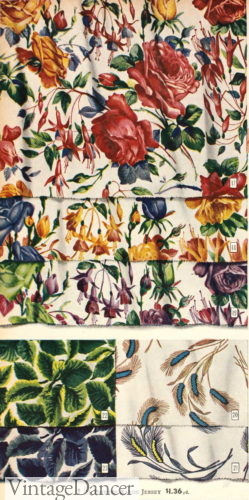
1945 rayon jersey
Silk: A rare and expensive fabric for most of the 1940s since it was needed to make parachutes and other military supplies. It is very light and shiny, which makes it popular for semi formal and evening attire. A shiny Rayon was a poor man’s alternative.
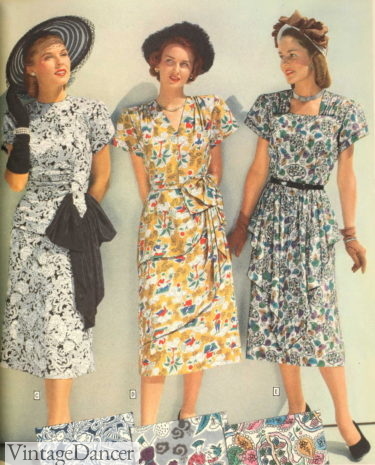
1947 peplum silk dresses
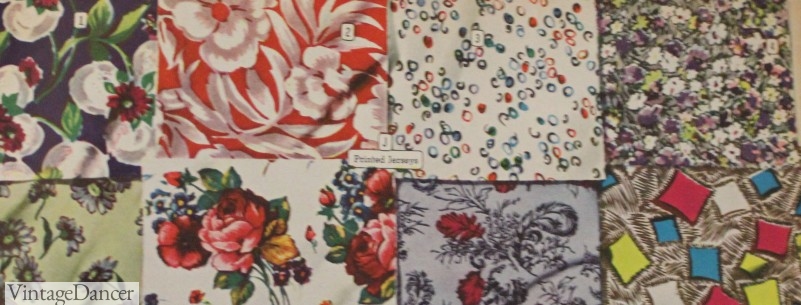
1947 night and day silks. Large and small flowers, and one very MOD art design.
Velvet: Velvet made another great evening gown material in winter. It’s not nearly as heavy as most velvet fabrics are today. Such a shame! It’s one of my favorites!
More about 1940s evening dress fabrics.
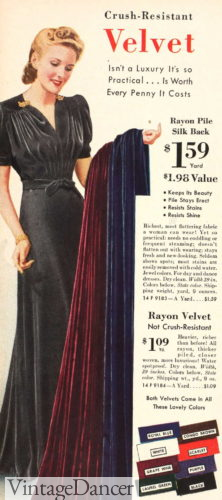
1940 rayon velvet fabric
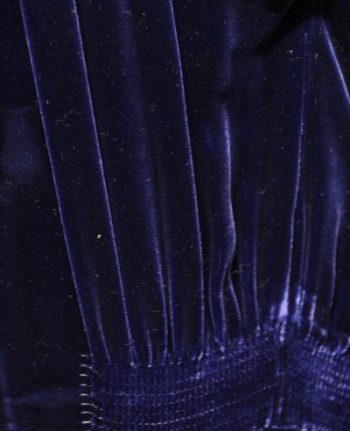
1940s blue velvet
Net: Net was used in most bridal gowns, bridal party dresses, and prom dresses in the 1940s. It was light, sheer and voluminous. Printed net was very popular, although from a distance the print is hardly noticeable.
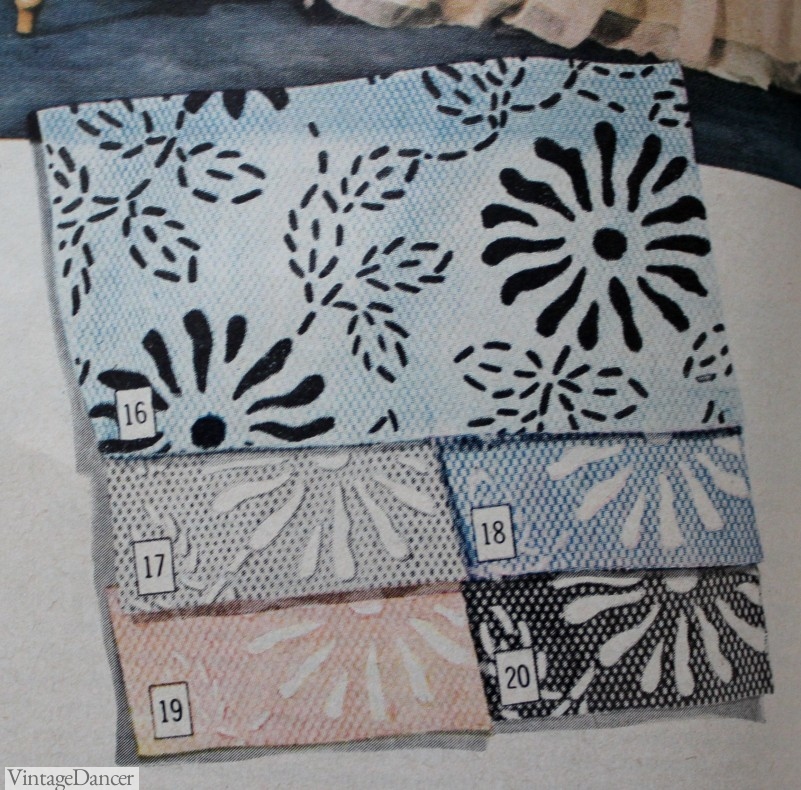
1944 Flocked net for Bridal or Party Gowns
Flannel: When I think of flannel, I think of cozy winter bed sheets. In fashion, flannel is a soft but sturdy material frequently used for men’s and women’s suits, dresses and separates. It is breathable and light, which makes it very comfortable!
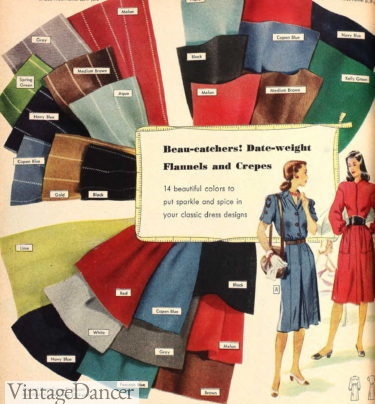
1947 wool flannel fabric
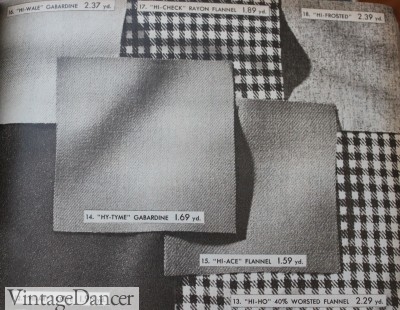
1948 wool and rayon blend fabrics in flat, crepe, flannel and gabardine textures. Black and white or brown and white checks were very common.
Flannelette was the soft flannel to sleep in. Pastel colors in stripes or plaid were the the most popular patterns.

1948 flannelette fabric
Gabardine – Another suiting type fabric made of wool or rayon blends. It had a twill-like texture and summer weight making it ideal for light jackets, slacksuits and sportswear. Smooth textured gaberdine could be used for suits and outwear.
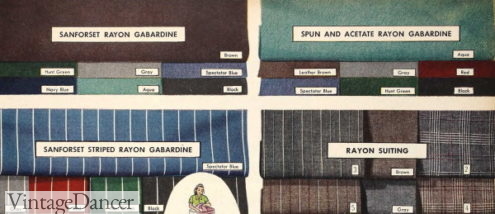
1948 suiting gabardine
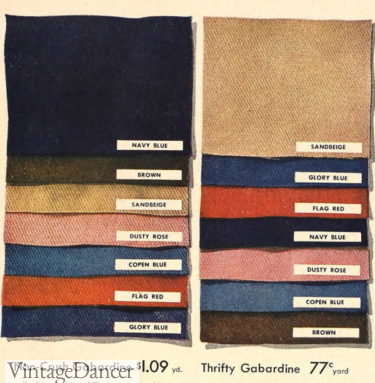
1944 twill-like gabardine
Chambrey – A very light and soft denim it was used for children’s clothes, sportswear, summer playsuits, and workwear. It was very popular when made in wide “Mexican stripes.”
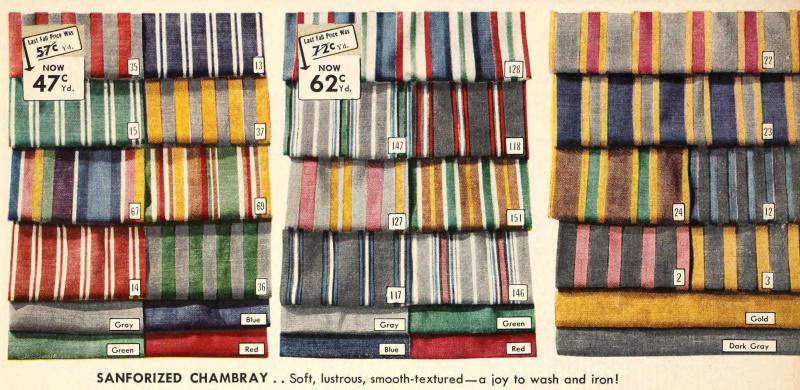
1949 striped chambrey
1940s Prints on Fabrics
There are some classics prints that are part of the 1940s, just as they were in the 1920s to 1960s too. They scream “vintage” whenever I make a dress with one.

White polka dots on solid color background
Polka Dots: Classic polka dots were common in the 1920s through the 1960s. Small and large, the 1940s, for the most part, preferred small dot prints. Dots on white was especially common in summer although white dots over colors were an option year round, especially as the dots grew larger.
When sewing a 1940s dress, you can’t go wrong with using polka dot fabric. They are very popular among ready-made retro dresses.
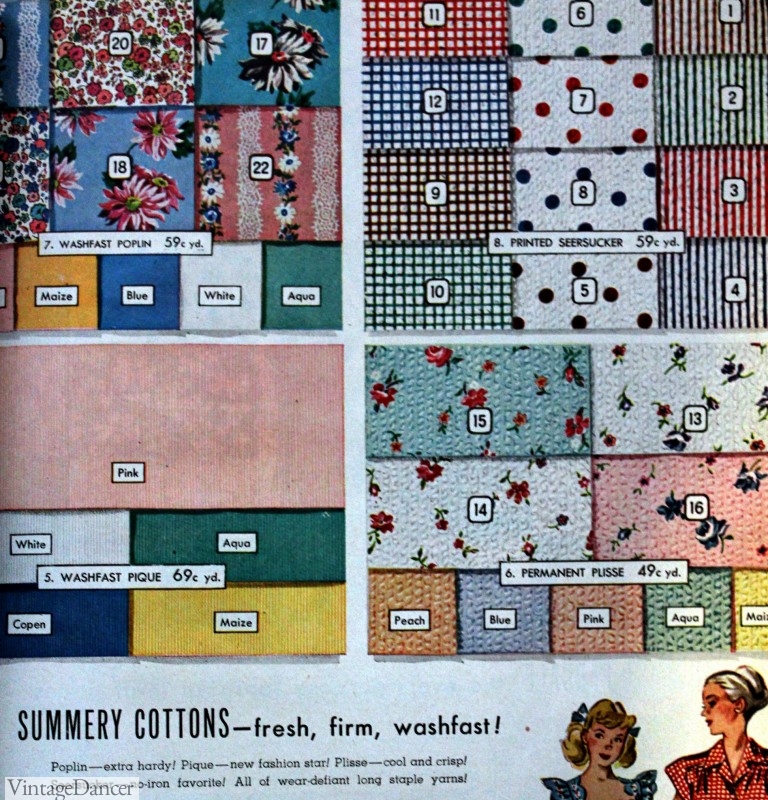
1948 spring cotton fabrics in small prints, dots, checks, stripes and solids.
Plaid: In winter, plaid was queen! But is was also popular in spring and summer too. The biggest fans of plaid were students and stay at home moms. Plaid skirts were part of every teen’s and woman’s wardrobe. Plaid jumpers or pinafore dresses were in every girl’s closet, too.
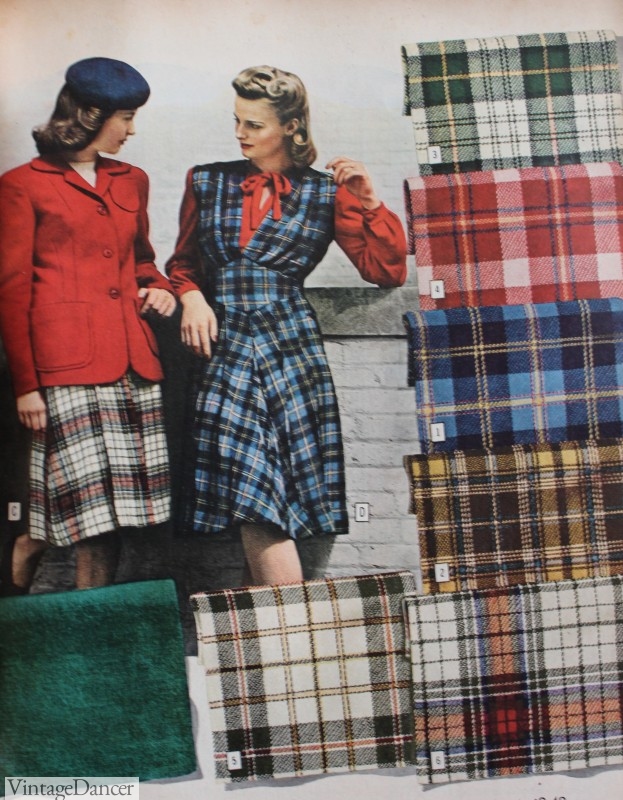
1944 Wool plaids made in jersey or twill texture.
Plaid cotton day dresses were made into any style imaginable. In winter, dark tartan plaids conveyed winter warmth while pastel plaids were ideal for spring. You don’t see many retro 1940s dresses made in plaid, which is a shame because it is another very ’40s, very classic, and an easy to find print.
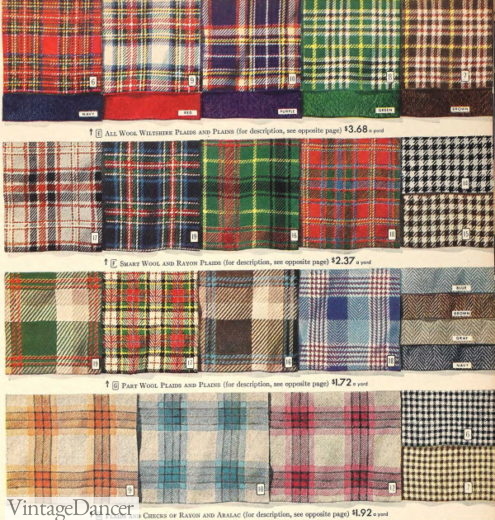
1944 plaid / tartan fabrics in wool or wool/rayon blends
Stripes: Small vertical stripes were another iconic design that is still easy to find in fabric stores today. Some stripes could be wide, but mostly they were a nice narrow width (not tiny pinstripes). Just like polka dots, they were usually on a white background.
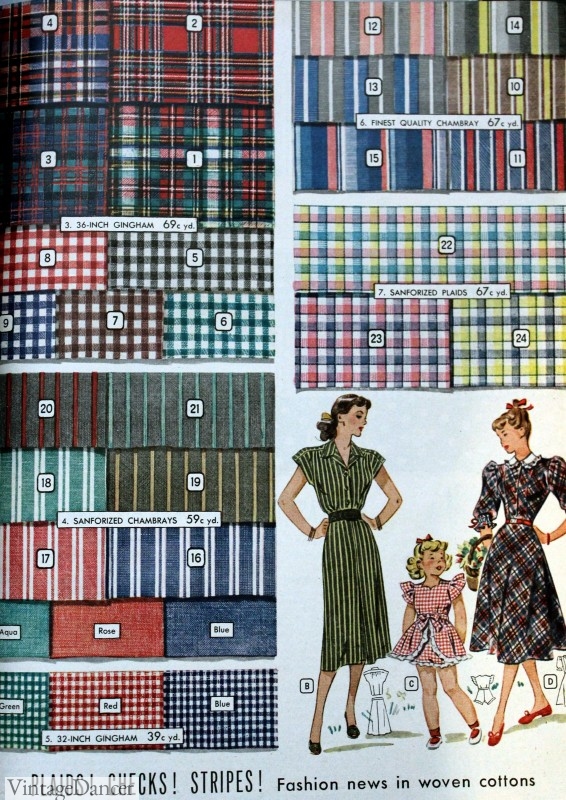
1948 woven cottons in plaid, gingham checks and stripes for spring.
Blue, red, brown, green, pink and yellow stripes made up the bulk of summer fashions. In the later 1940s, stripes were incorporated into fabrics with flowers and other motifs spread over them like vines. They also become more common as multi colors stripe prints.
-
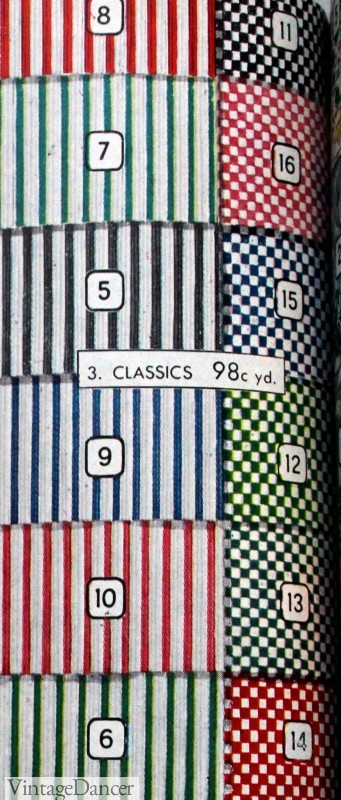
- Classic Stripes and Checks over white background
Checks: Very small check, often called gingham, was the other classic 1940s print. They were equally popular in summer (again on white) as well as in suits for winter. Black and white checks or brown and white check tweed fabric was a staple for many women’s suits and overcoats.
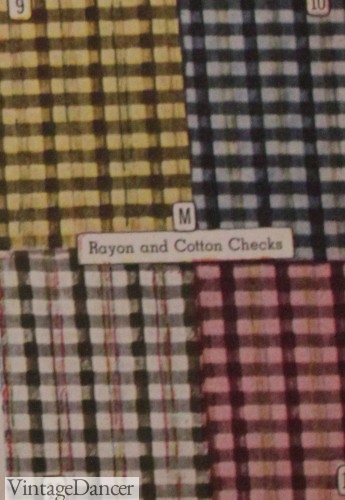
1947 Checks in Rayon or Cotton
Florals: When I think of 1940s prints, I think of small flower patterns. While small flowers are the most iconic, medium and large flowers were also present. However, the 1950s embraced extra large flower prints, so steer clear of those for your 1940s fashion.
The difference between ’40s flowers and ’30s or ’50s flowers is in the artistic rendering and colors. 1940s florals were vibrant, not subtle. They were not realistic but rather a splash of an artist’s paint brush. “Paint Brushed” designs were iconic of 1940s styles, whereas the 1950s liked “cute” or novelty designs and the 1920s and 1930s preferred Art Deco shapes.
To identify the difference between each decade is a lengthy lesson in art history, which I will spare you today. Instead, here are a bunch of floral prints to give you the right idea. Notice how floral prints start out small and grew bigger and bigger as the decade progressed.
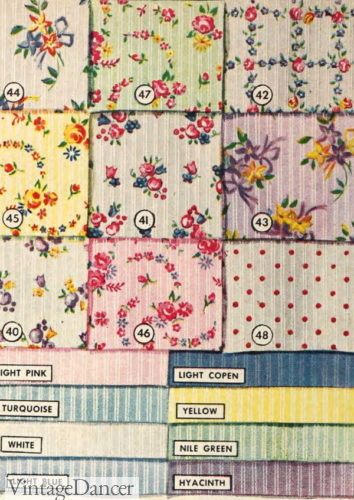
1942 Dimity floral, dot, stripe fabric
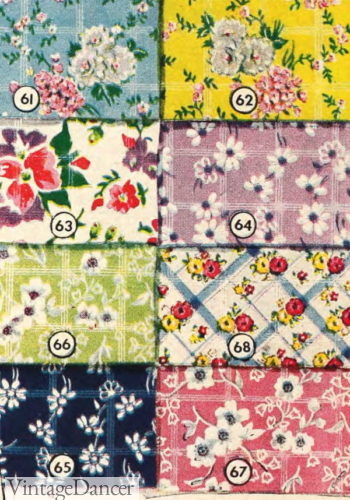
1942 lawn fabric, small florals
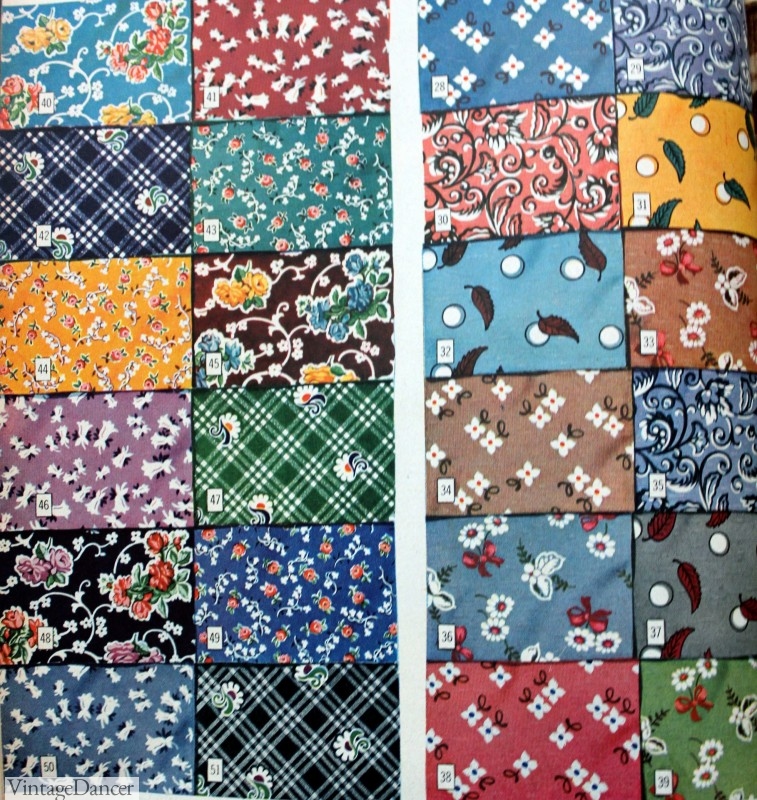
1944 Shantung textures in cotton and rayon blend prints
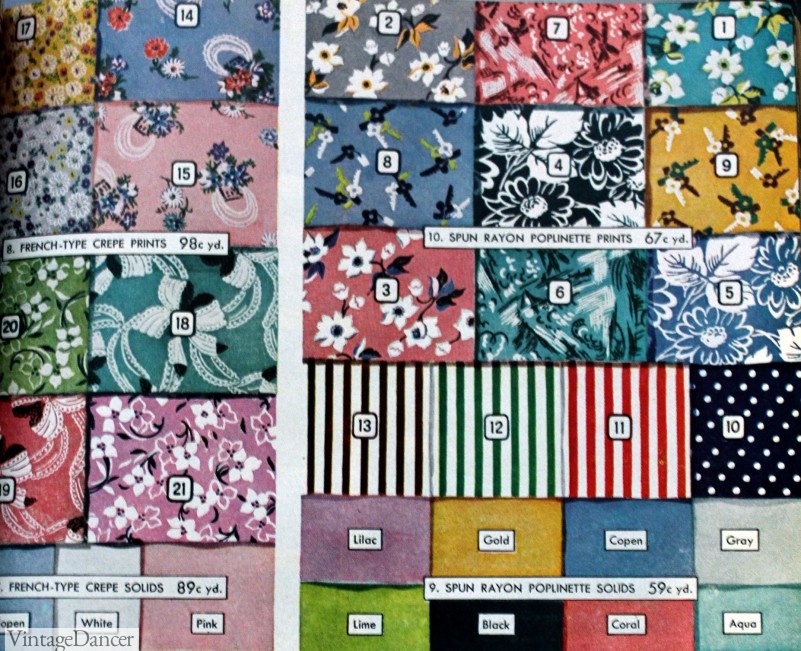
1944 Rayon in floral prints and plaids. Crepe and spun poplinette.
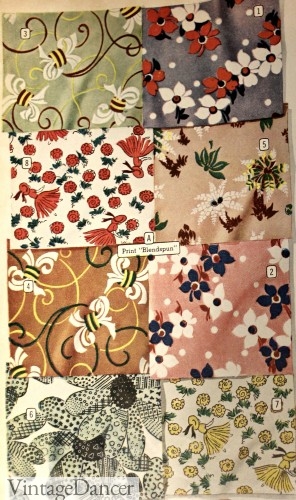
1947 prints
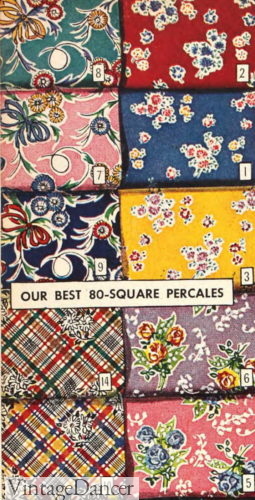
1948 floral percale cotton
Abstract: The abstract art movement was making its way into fashion by the late 1940s. Squiggly lines, interpretations of nature scenes, multi color stripes, and even paisley made an appearance. These are the designs that make up the bulk of 1950s prints as well.
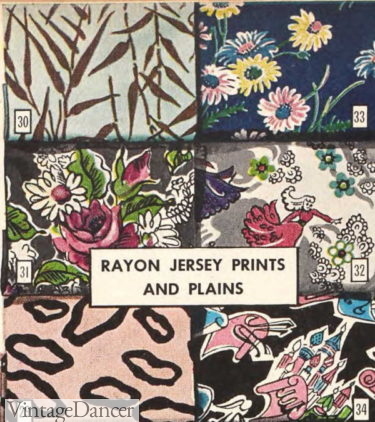
1948 rayon and jersey prints – florals and abstracts
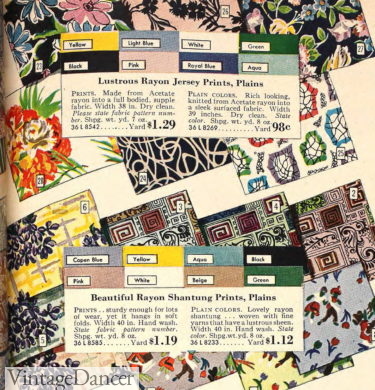
1948 rayon shantung fabrics in abstract prints
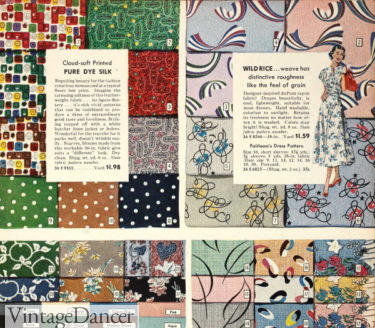
1948 rayon silk and linen abstract prints
Fabric Trims
An equally important part of women’s fashion was the trim that embellished dresses, blouses and skirts. White lace, Rickrack, or eyelet ruffle edging was the most popular way to decorate a casual dress.
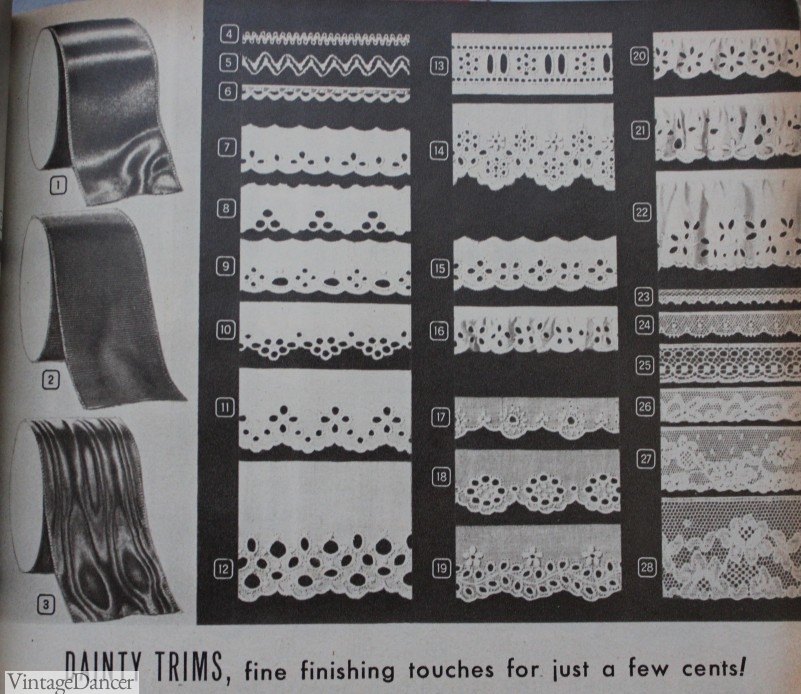
Ribbon for hats and big bows on girls dresses. White eyelet lace for ruffles and edgings. Ric-Rac came in red, green, royal blue, or white.
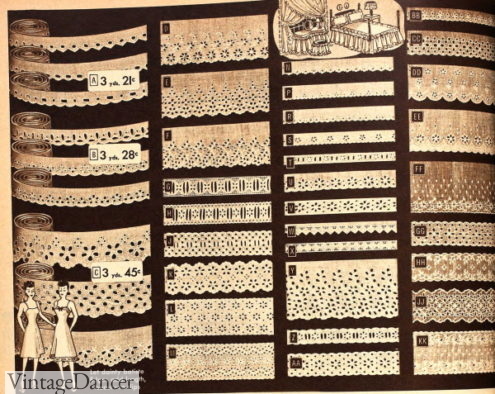
1948 eyelet ruffles and lace trim
Most semi formal dresses and suits didn’t attach trim in the from of ruffles, but made use of contrasting fabric, embroidered designs, pleats, drape and cording to add decoration. Sequin and rhinestone applique pieces could be added to fancy dress, gloves, sweaters and blouses.
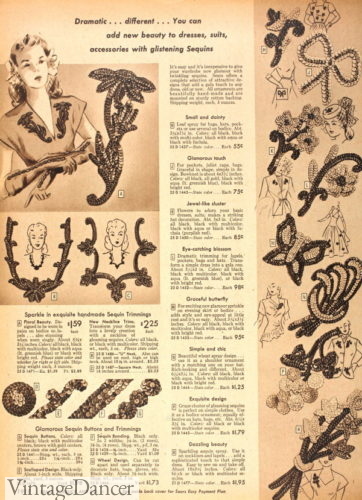
1945 sequin and rhinestone trim for dresses, gloves, sweaters, blouses, hats, jackets
Buttons in colorful plastics, novelty shapes, and basic white pearl were added to plain dresses. A boring button simple who not do. Women careful chose unique shapes and bold colors to stand out.
- 1941 buttons
- 1945 buttons
Where to buy 1940s fabrics:
Here are some of my favorite sites to buy vintage fabrics:
- Rick Rack – Original fabrics from the 1940s- mostly cotton prints. Feedsack prints too
- Antique Fabric.com – Large collection of original fabrics
- Vintage Fabrics.com.au/ (AU) – Many colorful fabrics for home and clothing. Ships worldwide
- Vintage Fabric Market.co.uk/ (UK) – Vintage fabrics, accessories and some vintage clothing
- Donna Flower.com (UK) – Charming collection of 1940s fabrics
- Spoonflower.com – Not vintage fabrics but many designs have been reproduced, so you will be getting new fabric with a retro design
- Fabric.com – An assortment of basic fabrics. Sometimes I find great options here
- Telalinda – 1920s-1940s reproduction fabrics
- Thai Silks – A huge assortment of silks and silk blends
- Renaissance Fabrics – Historical fabrics and trims
- Maltings Fabrics (UK) – Early 20th-century reproduction fabrics
- Liberty Fabrics (UK) – Cotton and lawn printed fabrics. Also silk and linen. You can find this brand at most USA quality fabric shops
- Farm House Fabrics – Cotton, lawn, suiting, silk and more
- Sew La Di Da (UK) – vintage inspired cotton, linen, crepe, etc
- Til The Sun Goes Down (UK) – Vintage inspired designs from the 20s-60s
- B Back and Sons – Wool, cashmere and silk. Wool suiting ideal for menswear
- Dharma Trading – Dyeable silk, cotton, rayon and linen fabrics
- NY Fashion Center – Fashion fabrics, all kinds
- Mood Fabrics – Designer fashion fabrics, all kinds. Trims and leather too
- Fashion Fabrics Club – More fashion fabrics
- Fabric Mart Fabrics – Organized by fabric type
- IKEA – some amazing historical clothing has been made from Ikea’s fabric and curtains
- Farthingale – Corset, garter, bra making supplies and some fabric
You don’t have to go with vintage fabrics for your clothing. I usually shop my local fabric stores first and see what I can find that closely resembles 1940s colors and patterns. Sticking to the “classic” prints will be easier than looking for a floral print. However, a quick search on fabric.com found me a few 1940s style options I like:
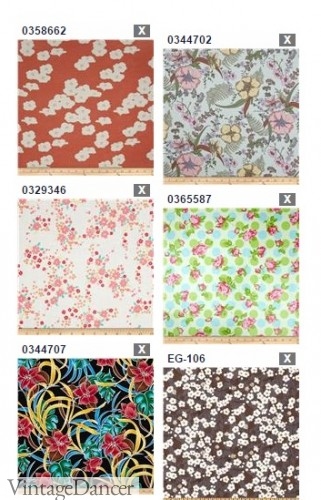
1940s style fabric prints at Fabrics.com
Vintage notions for sale:
- http://www.thebuttonbower.com/ – Buttons, buttons, buttons!
- http://www.accessoriesofold.com/ – Beads, buttons, trim, and more
- http://www.vintagebuttons.net/ – Buttons, jewelry and more
Where to buy 1940s patterns:
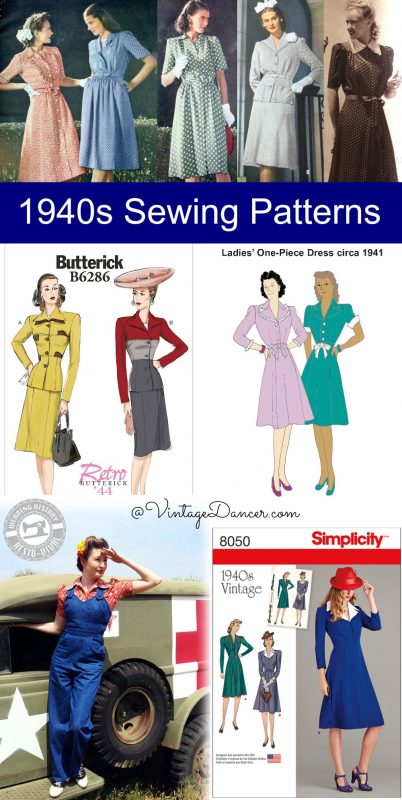
Pin this! 1940s sewing Patterns- Over 200 patterns for dresses, skirts, blouses, overalls, pants, coats, playsuits and lingerie!
There are a handful of 1940s reproduction pattern makers and each have their own level of difficulty. I recommend doing an online search for a review of a pattern before buying one. Also patternreview.com is an excellent source for reviews and online sewing lessons.
- http://www.pastpatterns.com/1940.html – Reproduction patterns you’ll love
- http://www.agelesspatterns.com/ – Reproduction dress patterns
- www.decadesofstyle.com – Patterns for apron, dresses, blouse, skirt, playsuit and pants
- http://www.reconstructinghistory.com/ – Reproduction patterns to fit modern bodies and sewing techniques. Men’s patterns too
- www.longago.com/forties.html – Some unique 40’s reproduction patterns
- http://www.wearinghistorypatterns.com/ – Fabulous dress, hat, trouser and playsuit patterns from the 1940s.
- http://www.edelweisspatterns.com/patterns.php – 1940’s dressed based on the Sound of Music movie costumes
- http://www.evadress.com/40s-01.html – Dress, slips, skirts, blouses, and trousers. Men’s trousers, jackets, ties, and smoking jacket
- http://www.neheleniapatterns.com/ (DE) – German pattern maker of women’s historical and vintage clothing
- http://rockinghorse-farm.com – Small collection of 4o’s clothing patterns
Where do you find fabric, patterns and notions? Let me know, so I can add to these lists!
Debbie Sessions has been teaching fashion history and helping people dress for vintage themed events since 2009. She has turned a hobby into VintageDancer.com with hundreds of well researched articles and hand picked links to vintage inspired clothing online. She aims to make dressing accurately (or not) an affordable option for all. Oh, and she dances too.
